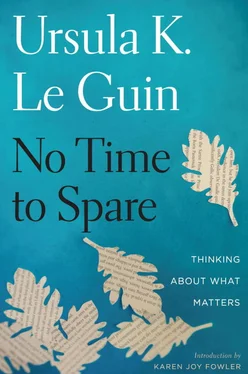I feel vaguely guilty about preferring a mere motel to a carefully planned, upscale residential resort. But the guilt is vague while the preference is clear and categorical. I like motels. Exclusivity isn’t my bag. “Gated communities” are not communities in any sense of the word I understand. I know that a great many of the people who own or time-share or rent places in these dry-side resorts go there not for the exclusive company of other middle-class white people but for the marvelous air and light of the high desert, the forests, the ski slopes, the spaciousness and silence. I know. That’s fine. Just don’t make me stay in one. Especially not one equipped with giant teddy bears.
But all this is merely preparation for getting to the lynx.
The lynx lives at the High Desert Museum. Briefly, when he was a kitten somebody pulled out his claws (“declawing” a cat is the same as pulling out a human being’s fingernails and toenails or cutting off the last joint of each toe and finger). Then they pulled out his four great cat fangs. Then they pretended he was their itty-bitty kitty. Then they got tired of him, or got scared of him, and dumped him. He was found starving.
Like all the birds and animals at the High Desert Museum, he is a wild creature who can’t survive in the wild.
His cage is inside the main building. It is a long enclosure with three solid walls and one glass wall. It has trees and some hiding places, and is roofless, open to the weather and the sky.
I don’t think I’d ever seen a lynx when I first met him. He is a beautiful animal, chunkier and more compact than a mountain lion. His very thick dense fur of a honeybuff color has a flowing scatter of dark spots on legs and flanks and goes pure white on belly, throat, and beard. Big paws, ever so soft-looking, but you wouldn’t want to be at the receiving end of one of those paws, even if its fierce, hooked weaponry has been torn out. Short tail, almost a stub—when it comes to tail, the mountain lion has it all over the lynx and bobcat. Lynx ears are rather queer and charming, with a long tip; his right ear is a bit squashed or bent. A big squarish head, with the calm, enigmatic cat smile, and great gold eyes.
The glass wall doesn’t look like one-way glass. I’ve never asked about it. If he is aware of the people on the other side of the glass, he doesn’t let them know it. He gazes out sometimes, but I have not seen his eyes catch on anything or follow anyone on the other side of the glass. His gaze goes right through you. You are not there. He is there.
I found and fell in love with the lynx during the last evening of a literary conference a couple of years ago. The writers at the meeting had been invited to a banquet at the museum to meet and mix with people who supported the conference with donations. This kind of thing is a perfectly reasonable attempt to reward generosity, though, knowing what writers are like, it must often be terribly disappointing to the donors. It is also an ordeal for many of the writers. People like me who work alone tend to be introverts and, indeed, uncouth. If piano is the opposite of forte, graceful chitchat with strangers is definitely my piano.
During the hour of wine and cheese before dinner, all the donors and writers milled about the main hall of the museum, talking. Being no good at milling and talking, and noticing a corridor off the main hall with no people in it, I sneaked off to explore it. First I found the bobcat (who must wake up now and then, though so far I have only seen him asleep). Then, getting farther away from the chatter of my species, going farther into dimness and silence, I came on the lynx.
He was sitting gazing out into the dimness and silence with his golden eyes. The pure gaze of the animal, Rilke called it. The gaze that is purely gaze: that sees through. For me, at that moment of feeling inadequate and out of place, the unexpected, splendid animal presence, his beauty, his perfect self-containment, was refreshment, consolation, peace.
I hung out with the lynx until I had to go back to the Bandar-log. At the end of the party I sneaked back for a moment to see him again. He was sleeping majestically in his little treehouse, great soft paws crossed in front of his chest. I had lost my heart for good.
I saw him again last year when my daughter Elisabeth drove me around eastern Oregon for four days (a grand trip, of which I hope to put a record in words and pictures on my site, if Elisabeth and I can goad each other into getting it together). She and I saw the displays and the otters and the owls and the porcupine and everything else at the museum, and ended in a long contemplation of the lynx.
And last week, before the reading, while Roger was doing all the hard work getting the books to sign into the museum, I could spend another half hour with him. When I came, he was pacing about, very handsome and restless. If he had a tail that was worth lashing he would certainly have been lashing it. After a few minutes he vanished through a big metal cat flap into some kind of back room not on view to the public. Fair enough, I thought, he wants some privacy. I went on to look at the live butterfly exhibit, which of course was lovely. The Oregon High Desert Museum is one of the most perfectly satisfying places I know.
When I came back down the corridor the lynx was sitting quite close to the glass, eating a largish bird. A grouse, was my guess. At any rate a wild bird, not a chicken. He had a tail feather hanging down from his chin for a while, which might have reduced his dignity in the eyes of beholders, but he does not acknowledge beholders.
He worked at his bird with diligence and care. He discussed his bird, as they used to say of people eating lamb chops. He was quite absorbed in discussing it. Lacking all four fangs, he was pretty much in the position of a human lacking incisors: he had to go at it sideways, with his molars. He did this neatly. It slowed him down, I am sure, but he never grew impatient, even when all he got was a mouthful of feathers. He just put a big soft honey-colored paw on his lunch and went at it again. When he got seriously inside the bird, some children who came by squealed, “Eeeyew! He’s eating the insides!” and some other children who came by murmured with satisfaction, “Oh look, he’s eating the guts.”
I had to go away then and do the reading and signing, so I could not see him finish lunch.
When I came back after an hour or so for a goodbye glimpse, the lynx was curled up comfortably asleep in his treehouse bedroom. One wing and a beak lay on the dirt near the glass wall. On three tree stumps, the servants of the lynx had laid out three dead mice—an elegant dessert presentation, as the fancy restaurants say. I imagined that later, when the museum closed, when all the primates had finally gone away, the big cat might wake up and yawn, and stretch himself lithely down from his treehouse, and eat his desserts one by one, slowly, in silence, all by himself in the darkness.
There is a connection that I am groping for, a connection between the resorts and the lynx. Not the noodly streets that took us from one to the other, but a mental connection that has something to do with community and solitude.
The resorts are neither city nor country; they are semi-communities. Most of their population is occasional or transient. The only day workers are gardeners, janitors, people doing upkeep. They don’t live in the nice houses. Most of the people that do are there not because their work takes them there but to get away from their work. They’re not there because they have common interests with others there but to get away from other people. Or to pursue sports such as golf and skiing, which pit the individual against himself. Or because they long for the solitude of the wilderness.
Читать дальше












